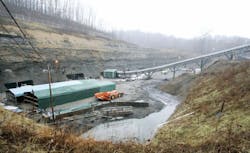The Federal Mine Safety and Health Review Commission has overturned a decision by Administrative Law Judge Jerold Feldman regarding Wolf Run Mining Co.’s response to the Jan. 2, 2006, explosion that killed 12 miners at the Sago Mine in Upshur County, W.Va.
MSHA cited Wolf Run Mining – now part of Arch Coal Inc. – for failing to immediately notify the agency and mine-rescue teams after the explosion, and for failing to follow the mine’s emergency-evacuation and firefighting protocol. In 2010, Feldman affirmed the violations but reduced the negligence levels from “high” to “moderate” and reduced the total fines from $14,500 to $11,000. The judge also vacated the “unwarrantable-failure” designation associated with the emergency-plan violation.
In a Dec. 23, 2013, decision, the commission overturned Feldman’s decision, concluding that Wolf Run’s failure to notify MSHA and mine-rescue teams immediately after the explosion involved unwarrantable failure and high negligence.
“Although eight years have passed, the memories of that tragic day have not diminished,” said Joseph Main, assistant secretary of labor for mine safety and health. “We are grateful for the commission’s decision in this case reaffirming the importance of immediate reporting of mine accidents.”
Although the explosion occurred at 6:26 a.m. local time on Jan. 2, 2006, the mine operator did not contact MSHA until 7:50 a.m., and did not make efforts to reach a mine-rescue team member at his home until 8:04 a.m., according to the agency.
Consequently, MSHA issued a citation and order to Wolf Run for failure to: immediately notify the agency of the explosion, comply with the mine’s emergency-evacuation and firefighting plan and immediately contact the mine-rescue team.
Feldman concluded that commission case law permitted the operator a reasonable opportunity to investigate the event prior to being required to contact authorities. He also reasoned that the operator’s negligence in not immediately reporting the incident was mitigated by mine management’s wish to execute a rescue attempt and to not be barred from entering the mine.
Feldman also took into account the fact that the explosion occurred on Jan. 2, when the nation was observing New Year’s Day (because Jan. 1 fell on a Sunday that year), so MSHA and state offices were closed, making it difficult to reach authorities.
On appeal, a two-member commission majority held, in agreement with MSHA, that Feldman erred because he:
- Miscalculated the time at which the mine operator’s duty to report commenced.
- Treated the intentional nature of the operator’s failure to report as a mitigating factor.
- Treated the fact that the explosion occurred on a federal holiday as a mitigating factor.
- Failed to consider the fact that when the operator finally attempted to report the explosion, it relied solely on an off-site management official who had limited knowledge of the explosion and limited information and resources available to him at home.
In addition to reinstating MSHA’s unwarrantable failure and high negligence designations, the commission assessed the company with MSHA’s proposed penalties of $1,500 and $13,000 for two separate citations.
“The operator’s intention to assist underground personnel during this emergency, while admirable, is exactly the type of conduct that the [Federal Mine Safety and Health Act of 1977] and the secretary’s regulations are intended to address and avoid,” the commission majority wrote. “The moments after a mining accident are difficult and frantic, but crucial to an effective response is strict adherence to an operator’s emergency plan and to the relevant MSHA standards governing conduct after an accident occurs.”
